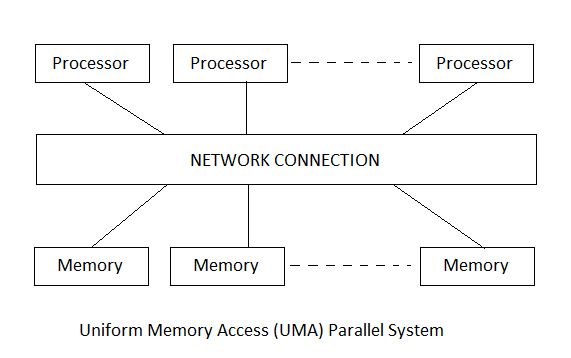Uniform Memory Access (UMA)
Uniform memory access (UMA) is a shared memory architecture used in parallel computers. All the processors in the UMA model share the physical memory uniformly. In UMA architecture, access time to a memory location is independent of which processor makes the request or which memory chip contains the transferred data.
There are three types of uniform memory access (UMA) architectures, they include:
- UMA using multistage interconnection networks.
- UMA using bus-based symmetric multiprocessing (SMP) architectures.
- UMA using crossbar switches.

What You Need To know About Uniform Memory Access (UMA)
- In Uniform Memory Access, memory access time is balanced or equal.
- There are three types of buses used in Uniform Memory Access, they include: single, multiple and Crossbar.
- Uniform memory access is used in time-sharing applications and general purpose applications.
- Uniform Memory Access, has less bandwidth when compared to Non-uniform Memory Access.
- Uniform Memory Access has a single memory controller.
- Uniform Memory Access is slower than Non-uniform Memory Access.
Non-Uniform Memory Access (NUMA)
Non-uniform memory access (NUMA) is a computer memory design used in multiprocessing where the memory access time depends on the memory location relative to the processor. NUMA architecture was developed largely due to the advent of modern microprocessors that are faster than memory speeds. As a result, local memory is placed closer to the processor, reducing signal path length together with latency times with fewer delays in accessing memory.
NUMA allows for faster and easy access to memory for the processors, as opposed to shared memory architectures where access times may be longer, thus slowing down execution of key processor and systems tasks.

What You Need To Know About Non-Uniform Memory Access (NUMA)
- In non-uniform memory access, memory access time is not balanced or equal.
- There are two types of buses used in Non-uniform Memory Access, they include: Tree and Hierarchical.
- Non-uniform Memory Access is used in real-time applications and time-critical applications.
- Non-uniform Memory Access has more bandwidth when compared to Uniform Memory Access.
- Non-uniform Memory Access has multiple memory controllers.
- Non-uniform Memory Access is faster than uniform memory access.
Also Read: Difference Between Semaphore And Mutex
Difference Between UMA And NUMA In Tabular Form
| BASIS OF COMPARISON | UMA | NUMA |
| Memory Access Time | Memory access time is balanced or equal. | Memory access time is not balanced or equal. |
| Types Of Buses | There are three types of buses used in Uniform Memory Access, they include: single, multiple and Crossbar. | There are two types of buses used in Non-uniform Memory Access, they include: Tree and Hierarchical. |
| Application | Used in time-sharing applications and general purpose applications. | Used in real-time applications and time-critical applications. |
| Bandwidth | Has less bandwidth when compared to Non-uniform Memory Access. | Has more bandwidth when compared to Uniform Memory Access (UMA). |
| Memory Controllers | Has a single memory controller. | Has multiple memory controllers. |
| Speed | It is slower than Non-uniform Memory Access (NUMA). | It is faster than uniform memory access (UMA). |
Comments are closed.